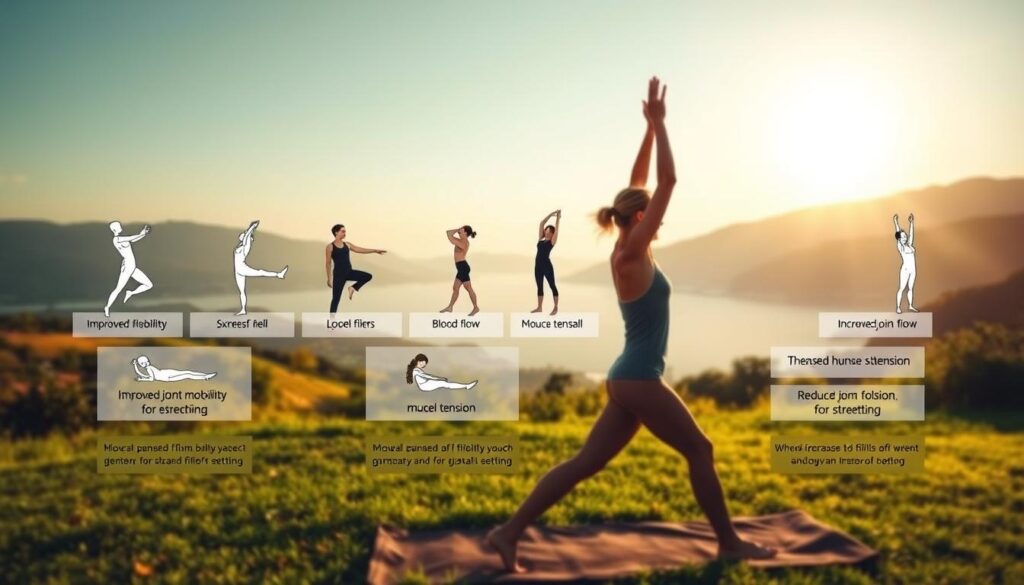Ever thought about how stretching can change your body and health? Flexibility is key, yet often ignored. This article will show you how to boost your flexibility through simple stretches.
Key Takeaways
- Flexibility is key for better mobility and performance.
- Regular stretching can prevent injuries.
- There are essential stretches for all fitness levels.
- Adding flexibility training to your day is easy.
- Follow safety tips for safe and effective stretching.
- More flexibility means better movement in daily life.
Introduction to Stretching and Flexibility
Stretching is key to a good fitness routine. It helps you move better and do daily tasks easily. Flexibility means how far your joints can move, which is important for staying upright and active.
Adding stretching to your day can bring many benefits. It boosts blood flow and makes muscles work together better. It also helps prevent injuries by letting your body move smoothly.
Before hard workouts, do dynamic warm-ups like hip circles and arm swings. Static stretches, like hamstring and shoulder stretches, help muscles heal and improve flexibility. For more tips, check out this resource for exercises you can do at home.
Benefits of Stretching Exercises for Flexibility
Adding stretching exercises to your routine has many benefits. It boosts your flexibility, which means you can move more easily. This also helps prevent injuries. Stretching eases muscle tension and improves blood flow, which is key for recovery after hard workouts.
Stretching also helps you perform better in sports. It makes your muscles ready for action. This can help you recover faster and keep up with your workout schedule. Knowing these benefits is important for staying healthy and performing well.
Staying consistent with stretching can help you stay flexible as you get older. This improves your daily movements. It makes your life more active and enjoyable.
| Benefit | Description |
|---|---|
| Increased Flexibility | Enhances range of motion in joints and muscles. |
| Reduced Muscle Soreness | Aids recovery and minimizes discomfort post-workout. |
| Enhanced Mobility | Improves functional movements in everyday life. |
| Injury Prevention | Decreases the risk of strains and sprains during physical activity. |
| Better Circulation | Promotes blood flow, helping muscles recover more efficiently. |
How Stretching Enhances Your Mobility
Stretching is key to better mobility, which is vital for your physical health. It boosts blood flow to muscles and joints. This helps warm up your body and gets your muscles ready for action.
Adding stretching to your daily routine makes a big difference. It stretches muscles and tendons, making your joints more flexible. This is great for activities like squatting, bending, or reaching, where you need to move well.
Stretching also helps your joints work better. It eases stiffness in areas like the hips, knees, and back. These areas often get tight from sitting too much. Stretching makes it easier to do everyday tasks.
The table below shows how different exercises help with flexibility and performance:
| Type of Exercise | Benefits | Ideal For |
|---|---|---|
| Static Stretching | Increases flexibility, reduces muscle tension | Post-exercise routines |
| Dynamic Stretching | Enhances blood flow, prepares muscles for action | Warm-up sessions |
| Foam Rolling | Relieves tightness, improves recovery | Pre or post-workout |
| Yoga | Promotes overall flexibility, balance, and strength | Wellness and recovery |
Adding these exercises to your routine will improve your movement over time. Regular stretching boosts your mobility and encourages a healthier lifestyle.
Essential Stretching Exercises for Flexibility
Adding essential stretching exercises to your routine boosts flexibility. These stretches target different muscle groups. They help improve mobility and overall wellness. Here are some top stretches for flexibility to add to your workout.
- Calf Stretch: Stand near a wall, place one foot forward while the other is stretched back, keeping your heels flat on the ground. This stretch is key for the calf muscles, great for runners.
- Hamstring Stretch: Lying on your back with one leg against the wall stretches the hamstrings. It’s vital for flexibility in the back of your thighs.
- Quadriceps Stretch: Stand and gently grasp one ankle, bringing the heel towards your glutes. This stretch works the front thigh muscles and supports knee health.
- Hip Flexor Stretch: Kneel with one foot in front, shifting your weight forward. This stretches the hip flexors, important for those who sit a lot.
Flexibility Training for Beginners
Starting your flexibility training journey can be very empowering. Begin with stretches that gently work on major muscle groups. This helps build a strong base and boosts your flexibility.
Beginner-friendly stretches like hamstring or shoulder stretches are easy to add to your day. They’re great for beginners.
Gentle yoga is a wonderful way to start with flexibility training. It focuses on control and breathing, helping you connect with your body. Move slowly and carefully to get the most out of it and avoid injuries.
Before stretching, do some warm-up exercises to get your muscles ready. Make sure to set aside time each day for these stretches. With regular practice, you’ll see big improvements in your flexibility and feel more comfortable during activities.
Incorporating Flexibility Stretches into Your Routine
It’s important to make stretching a regular part of your life. Try to stretch 2 to 3 times a week. Stretching works best after you’ve exercised, when your muscles are warm and ready.
Stretching also helps during the day, like when you’re sitting for a long time. It keeps you from getting stiff.
Stretching is best after you’ve worked out or in the morning. It gets your day started right. Make stretching a habit by setting aside time for it every day.
| Time of Day | Benefits | Recommended Stretches |
|---|---|---|
| Morning | Increases blood flow and improves mobility for the day ahead | Cat-Cow, Standing Forward Bend |
| Post-Workout | Helps prevent muscle soreness and enhances recovery | Hamstring Stretch, Quadriceps Stretch |
| During Breaks | Relieves tension and prevents stiffness | Neck Stretch, Shoulder Rolls |
By adding stretches to your daily routine, you’ll see your flexibility improve. You’ll feel better overall too.
Safety Tips for Effective Stretching
When you stretch, safety should always come first. Begin with a light warm-up to get your muscles ready. This step helps prevent injuries by boosting blood flow.
It’s important to stretch safely. Never stretch too far beyond what feels right. Hold each stretch for 20 to 30 seconds and breathe deeply. This method improves flexibility and relaxes you.
Don’t bounce while stretching. Bouncing can cause muscle strain and injuries. Instead, move smoothly and control your stretches. Paying attention to your body helps avoid common mistakes and keeps you safe.
Regularly practicing safe stretching will lead to better results. Always listen to your body and adjust your routine if needed. Following these tips will make your stretching sessions more effective.
Advanced Flexibility Exercises for Improved Performance
Looking to boost your physical abilities? Advanced flexibility exercises are key. They help improve your performance. Dynamic vs static stretching is important in this process. Dynamic stretching gets your muscles ready for hard work by moving them slowly.
After working out, use static stretching to recover and keep flexibility. PNF (Proprioceptive Neuromuscular Facilitation) is great for stretching muscles. It helps increase your range of motion, essential for sports.
Mix dynamic and static stretching in your routine. This mix keeps your muscles growing and improves flexibility. Advanced exercises support better performance and balanced muscle growth. For jump improvement, see this guide on Pilates for jumping.
Conclusion
Stretching is key to better flexibility and mobility. Adding stretching to your daily routine brings many benefits. It helps improve how well you move and lowers injury risk.
It’s not just for athletes. Anyone wanting to stay active needs to know stretching’s value. It’s important for your health and happiness.
Stretching does more than just help you move better. It makes daily tasks easier and more fun. A regular stretching habit can greatly improve your health and happiness.
Flexibility training is a long-term commitment. By making stretching a part of your routine, you improve now and for the future. As you keep stretching, you’ll notice big changes in your daily life.
FAQ
What are the benefits of stretching exercises for flexibility?
Stretching exercises make you more flexible and mobile. They also help reduce muscle soreness after working out. Plus, they aid in recovery and reverse muscle stiffness from sitting too long.
How often should I incorporate flexibility stretches into my routine?
Stretch at least 2 to 3 times a week, best after exercising. You can also stretch during the day to ease tension from sitting.
What are some beginner-friendly stretching exercises?
Start with simple stretches like calf, hamstring, quadriceps, and hip flexor stretches. These target big muscle groups and boost flexibility.
How can I improve flexibility through stretching?
Boost flexibility by stretching regularly, focusing on tight areas. Practice both static and dynamic stretches to improve mobility and joint function.
What safety tips should I follow when stretching?
Start with a light warm-up to get your muscles ready. Never stretch too far and hold each stretch for 20 to 30 seconds. Avoid bouncing to prevent injury and listen to your body.
Are advanced stretching exercises beneficial, and what do they include?
Yes, advanced stretches can greatly enhance performance. They include dynamic stretches for warm-ups and static stretches after exercise. Techniques like Proprioceptive Neuromuscular Facilitation (PNF) also help improve flexibility.
Can I include flexibility training in other workouts?
Definitely! You can add flexibility training to workouts like yoga or Pilates. This balances your fitness routine and boosts flexibility and range of motion.





